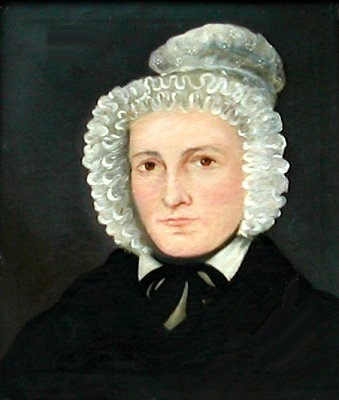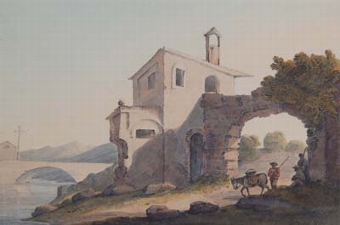Salvator Rosa (1615 ? March 15, 1673) was an Italian Baroque painter, poet and printmaker, active in Naples, Rome and Florence. As a painter, he is best known as an "unorthodox and extravagant" and a "perpetual rebel" proto-Romantic. He was born in Arenella, in the outskirts of Naples, on either June 20 or July 21, 1615. His father, Vito Antonio de Rosa, a land surveyor, urged his son to become a lawyer or a priest, and entered him into the convent of the Somaschi fathers. Yet Salvator showed a preference for the arts, and secretly worked with his maternal uncle Paolo Greco to learn about painting. He soon transferred himself to the tutelage of his brother-in-law Francesco Francanzano, a pupil of Ribera, and afterwards to either Aniello Falcone,a contemporary of Domenico Gargiulo, or Ribera himself. Some sources claim he spent time living with roving bandits. At the age of seventeen he lost his father; his mother was destitute with at least five children, and Salvator found himself without financial support.
He continued apprenticeship with Falcone, helping him complete his battlepiece canvases. In that studio, it is said that Lanfranco took notice of his work, and advised him to relocate to Rome, where he stayed from 1634?36.
Returning to Naples, he began painting haunting landscapes, overgrown with vegetation, or jagged beaches, mountains, and caves. Rosa was among the first to paint "romantic" landscapes, with a special turn for scenes of picturesque often turbulent and rugged scenes peopled with shepherds, brigands, seamen, soldiers. These early landscapes were sold cheaply through private dealers.
He returned to Rome in 1638-39, where he was housed by Cardinal Francesco Maria Brancaccio, bishop of Viterbo. For the Chiesa Santa Maria della Morte in Viterbo, Rosa painted his first and one of his few altarpieces with an Incredulity of Thomas.
While Rosa had a facile genius at painting, he pursued a wide variety of arts: music, poetry, writing, etching, and acting. In Rome, he befriended Pietro Testa and Claude Lorraine. During a Roman carnival play he wrote and acted in a masque, in which his character bustled about Rome distributing satirical prescriptions for diseases of the body and more particularly of the mind. In costume, he inveighed against the farcical comedies acted in the Trastevere under the direction of Bernini.
Self-portrait, circa 1645 (Mus?e des Beaux-Arts de Strasbourg)
While his plays were successful, this also gained him powerful enemies among patrons and artists, including Bernini himself, in Rome. By late 1639, he had had to relocate to Florence, where he stayed for 8 years. He had been in part, invited by a Cardinal Giancarlo de Medici. Once there, Rosa sponsored a combination of studio and salon of poets, playwrights, and painters?the so called Accademia dei Percossi ("Academy of the Stricken"). To the rigid art milieu of Florence, he introduced his canvases of wild landscapes; while influential, he gathered few true pupils. Another painter poet, Lorenzo Lippi, shared with Rosa the hospitality of the cardinal and the same circle of friends. Lippi encouraged him to proceed with the poem Il Malmantile Racquistato. He was well acquainted also with Ugo and Giulio Maffei, and housed with them in Volterra, where he wrote four satires Music, Poetry, Painting and War. About the same time he painted his own portrait, now in the National Gallery, London.
Landscape with Tobit and the angel, circa 1670 (Mus?e des Beaux-Arts de Strasbourg)
In 1646 he returned to Naples, and appears to have sympathized with the 1648 insurrection of Masaniello, as a passage in one of his satires suggests. His actual participation in the revolt is dubious. It is alleged that Rosa, along with other painters?Coppola, Paolo Porpora, Domenico Gargiulo, Pietro dal Po, Marzio Masturzo, the two Vaccari and Cadogna?all under the captaincy of Aniello Falcone, formed the Compagnia della Morte, whose mission it was to hunt down Spaniards in the streets, not sparing even those who had sought religious asylum. He painted a portrait of Masaniello?probably from reminiscence rather than life. On the approach of Don Juan de Austria, the blood-stained Compagnia dispersed.
Other tales recount that from there he escaped and joined with brigands in the Abruzzi. Although this incident cannot be conveniently dove-tailed into known dates of his career, in 1846 a famous romantic ballet about this story titled Catarina was produced in London by the choreographer Jules Perrot and composer Cesare Pugni).
He returned to stay in Rome in 1649. Here he increasingly focused on large scale paintings, tackling themes and stories unusual for seventeenth-century painters. These included Democritus amid the Tombs, The Death of Socrates, Regulus in the Spiked Cask (these two are now in England), Justice Quitting the Earth and the Wheel of Fortune. This last work, with its implication that too often foolish artists received rewards they did not match their talent, raised a storm of controversy. Rosa, endeavouring at conciliation, published a description of its meaning (probably softened down not a little from the real facts); nonetheless he was nearly arrested. It was about this time that Rosa wrote his satire named Babylon.
A landscape by Salvator Rosa.
His criticisms of Roman art culture won him several enemies. An allegation arose that his published satires were not his own, but stolen. Rosa indignantly denied the charges, but one must admit that the satires deal so extensively and with such ready manipulation of classical names, allusions and anecdotes, that one is rather at a loss to fix upon the period of his busy career at which Rosa could possibly have imbued his mind with such a multitude of semi-erudite details. It may perhaps be legitimate to assume literary friends in Florence and Volterra coached him about the topic of his satires, as compositions, remaining nonetheless strictly and fully his own. To confute his detractors he now wrote the last of the series, entitled Envy.
Among the pictures of his last years were the admired Battlepiece and Saul and the Witch of Endor (latter perhaps final work) now in Louvre, painted in 40 days, full of longdrawn carnage, with ships burning in the offing; Pythagoras and the Fishermen; and the Oath of Catiline (Pitti Palace).
While occupied with a series of satirical portraits, to be closed by one of himself, Rosa was assailed by dropsy. He died a half year later. In his last moments he married a Florentine named Lucrezia, who had borne him two sons, one of them surviving him, and he died in a contrite frame of mind. He lies buried in Santa Maria degli Angeli e dei Martiri, where a portrait of him has been set up. Salvator Rosa, after struggles of his early youth, had successfully earned a handsome fortune.
He was a significant etcher, with a highly popular and influential series of small prints of soldiers, and a number of larger and very ambitious subjects.
Antiques.co.uk Ref: 9MUYV2YW
- Materials:
- Oil on Canvas
- Width (cm):
- 30 x 25in. (76 x 64cm.)












